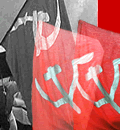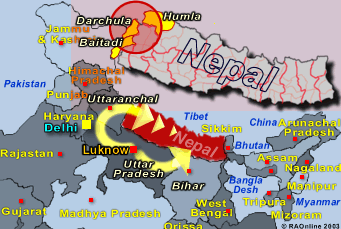
|
| The People's War in Nepal: Maoists' Strategy |
 |
|
 |
| Maoist rebels want to change their strategy |
October 2003
Change of targets
Amidst fresh reports of violent conflicts, the Maoist leadership pledged to not take physical action against party leaders and activists, low-ranking security personnel and physical infrastructures.
The
CPN-Maoist president and headman Prachanda announced the rebels would now
target US-backed organisations and halt attacks on government infrastructure.
He signalled a shift away from attacks on government buildings, telecommunications
and other infrastructural works. Prachanda said Nepalese police would be
given a chance to leave the force rather than be killed. Aid groups not
funded by the US would be allowed to work in villages after consultations
with the rebels, the rebel's most senior leader said. A new "tax" on businesses
would replace extortions.
Change of smuggling routes
The
Maoists, during the ceasefire period, smuggled in arms and ammunitions
from Indian territories and other countries.
Most
of the arms were brought in from Bihar and Uttar Pradesh of India.
The arms were purchased in the open weapon market of Lucknow, the state
capital of Uttar Pradesh. After the breakdown of the ceasefire the Maoists
have altered the arms smuggling routes for security reasons. Before the ceasefire, arms were being smuggled through western Terai districts. Since a couple of months, the Maoists have mostly been using northern points of western Nepal to bring in arms. The entry points include Muchu and Taklakot of Humla district, and other places of Darchula and Baitadi districts. |

|
Maoists
rebels have contacts with the Indian rebel groups, such as Maoist
Communist Center and People's War Group. These groups are dealing with
weapons and provide logistics.
Maoists smuggling explosives from India, Tibet
Maoist
rebels are smuggling explosives and arms into the country from Indian and
Tibetan borders in the far western region.
The
primary route used by the rebels is the Belauri checkpoint of Kanchanpur
district and Melauli checkpoint at the border of Dadeldhura and Baitadi
districts.
The
Maoists are purchasing explosives from staff of the Dhauli Ganga hydro
project at Dharchula in India. The Maoists are also smuggling arms and
explosives in from the Tibetan border via Jharganda and Taklako.
Once the explosives have been smuggled into Nepal, their next destination
is usually Bajura and Achham.
New phase of war?
The
Maoists on the other hand by launching attacks on Armed Police Force bases
in Bhaluwang and Kusum, initiated a new phase in armed movement, which
so far was concentrated in the hills. The armed offensives, though unsuccessful,
meant the Maoists had shifted their focus to Terai and mostly concentrated
in urban centres.
 |
 |